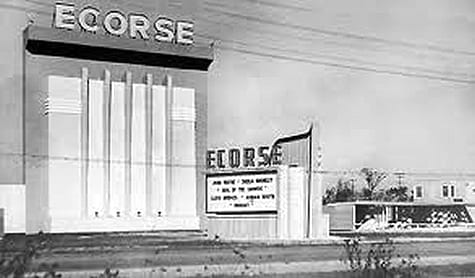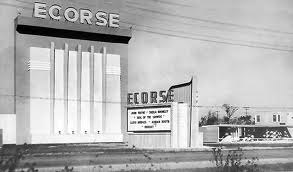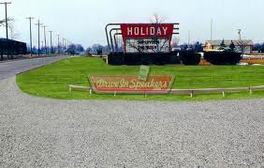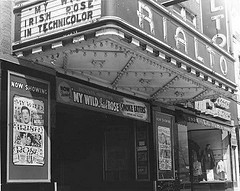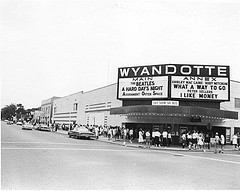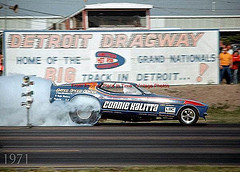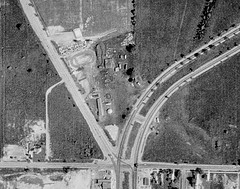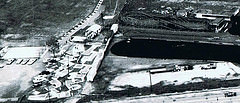Downriver Nostalgia
ECORSE, FORT GEORGE, HOLIDAY, JOLLY ROGER, MICHIGAN DRIVE-INS
|
|
|
The drive-in era began in earnest in 1932 with the brainchild of Richard M. Hollingshead, Jr., and Downriver certainly enjoyed its share of facilities. The Ecorse (1951-1989), Fort George (1950-1990), Holiday (1956-1986), Jolly Roger (1954-1990) and Michigan (1948-1984) were the places to be in the days before the modern multi-plex. The Ecorse was famed for being destroyed during the Derecho (Green Storm) of July 16, 1980, but was rebuilt.
|
WYANDOTTE’S TRIO OF DOWNTOWN THEATERS
MAJESTIC THEATER REVIEW: FEBRUARY 1916 |
WYANDOTTE THEATER: PURPOSE BEHIND MULTI-SCREENS? |
FAST FACTS ON THE RIALTO THEATER:The Rialto’s address was 2938 Biddle Avenue and had seating for 600. It was taken over by the Associative Theaters chain in 1939. By the 1950s it ended its original run, and was now operated as a religious theater by “Bible and Christian Books.” According to Boxoffice magazine, this venture was concluded sometime before its August 25, 1956 issue.
|
Information tabbed from a 1942 blurb from Boxoffice Magazine may provide a hint: The theater was opened – with one screen – in 1938, with capacity of 1,500. Not until the August 16, 1941 edition of Boxoffice was there a mention of a duplex screen in the works, as materials had been ordered from the National Theater (supply) Company. A further Boxoffice publication, dated January 10, 1942, stated that the section known as the “Annex” opened New Years Day, 1942. The original idea was to show a double-feature in the main section, with one feature and short subjects (Laurel & Hardy, Three Stooges, etc.) in the Annex. However, this was not initially the way management worked out the arrangement. They would show the exact same pictures on both screens, but at staggered times; this way, more people could see the same two features on any given day. The Wyandotte Theater (address: 102 Elm) would outlast – by far – the lifespans of the Majestic and Rialto. It would briefly (and unfortunately) enter into the X-rated movie world in the mid-1970s, just as many theaters were doing. Wyandotte shed that reputation quickly and the theater would be back doing first-run movies in the 1980s. |
DETROIT DRAGWAY
With perhaps the three most famous words ever uttered among Downriver sports enthusiasts, “Sunday! Sunday! Sunday!” would rock the area from the Detroit Dragway on Sibley Road from 1959 to 1998. It was apparently very obvious that racing was huge in the area, as the Dragway hosted the U.S. Nationals in 1959 and 1960 – its first two years of operation! Opened and operated by Gil Kohn and promoted by Ben Christ, the two men would dream up the “Sunday” advertising campaign which would last for decades. It highest purse was $40,000 set at the 1978 Summer Nationals, but the crowds (averaging 30,000 on a good night) – and even the drivers – may have told you they were in it for the fun and action, as well as the money. On summer nights when the wind blew gently from the south, the engines could be heard roaring as far north as Lincoln Park. Between the Detroit Dragway and Flat Rock Speedway, racing enthusiasts’ needs were very well met.
Crowds began to thin and conditions began to deteriorate in the 1980s. By 1991, average turnout struggled to hit 500. Tastes may have changed in the next generations, but management was sticking to their guns and planning a million-dollar overhaul of the course in 1994. By that time, however, new residences had sprung up to the track’s south and west, and the new residents did not agree with the Dragway’s continued operation… in much the same way new residents disliked the noise from the Indian City Radio Control club site one mile north. The track closed in 1998; on its site now are a series of logistics and warehouse companies making up the Brownstown Business Center.
LANGE WATER PARK
To know this once-bustling park as anything other than one in its current shape would be unfair; however, such visual evidence to the contrary is not readily apparent. Much of its early history is shrouded in mystery, although it was billed as Lange Water Park from at least the late 1960s.
By the mid-1980s the land was considered abandoned with most of the carnival structures dismantled, although some out-buildings would remain and the original park layout remained the same. Small signs had been placed on either end of Lange Road (at Northline and Eureka) in an effort to draw people to the park.
By the early 1990s, it would morph into the Extreme Limits paintball park, utilizing most of the available acreage. Feedback found on various paintball review sites of the late 1990s lauded Extreme Limits for its great atmosphere, deceiving layout, and many natural obstacles which added to gameplayers’ experience. The current status of the park and property are unknown, although signs on either end of Lange Road are still there.
We are searching for more clues from this mysterious timeline; please feel free to contact us with your thoughts and recollections!
WONDERLAND AMUSEMENT PARK
This fixed carnival midway was located where Fort, Pennsylvania and Trenton Roads converge in Southgate. A very small competitor when compared with Bob-Lo Amusement Park, Wonderland nonetheless enjoyed a great advertising campaign (it had its own parade float as shown above), prime location and vast variety of attractions & rides for a park of its size. It undoubtedly drew upon Detroit’s old Edgewater Park as a partial inspiration.
No ground-level photos exist of the overall complex; nor do definitive opening and closing dates. It may have pre-dated the opening of the Fort George Drive-In Theater by a couple of years (likely in the late 1940s). Aerial photos show these (by the early 1950s) as the only solid developments along Fort between Leroy and Pennsylvania Roads. Various sources have opined Wonderland lasted into the 1960s, some as late as 1966. Korvette and Shopper’s Fair were immediate neighbors of the park by then, but they obviously did not help provide extra foot traffic for Wonderland. Ironically, the Korvette parking lot would hold an annual travelling carnival well into the 1980s. The Wonderland area was most likely cleared by either 1968 or 1969 to make way for the Stu Evans Lincoln-Mercury dealership.
As Wonderland was in existence for upwards of twenty years, we are searching for more clues from its mysterious timeline. Feel free to contact us if you have more specific information or photos.
Thanks to Downriver History for the contribution to this post.


